Free Flight's Fabulous February
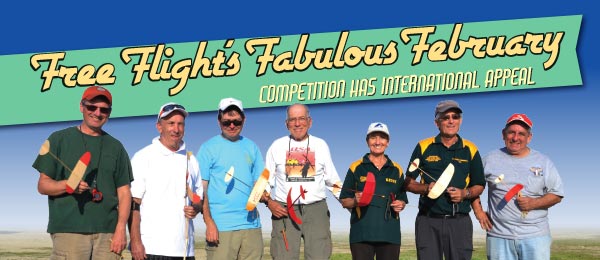
Written by Don DeLoach Competition has international appeal Event coverage Photos by the author except as noted As seen in the July 2016 issue of Model Aviation.
Twelve individual World Champions in Free Flight were among the approximately 200 international competitors at Lost Hills, California, February 6-14, 2016. The potpourri of Free Flight, which has come to be known as Fabulous February, is actually six contests in one. It begins with the Issacson Winter Classic, a multifaceted tapestry of Free Flight including AMA and Nostalgia (1950s) events and entry-level events such as P-30 and E-36. Concurrent with the Issacson Winter Classic weekend is the Kiwi Cup of New Zealand, the first of three FAI World Cups for F1A, F1B, F1C, F1P, and F1Q. On Tuesday there’s another World Cup for F1A, F1B, F1C, F1P, F1Q, and the Pan American Cup of Canada, followed by two World Cups for F1E (Slope Soaring) gliders. The main event on the final Friday through Sunday is the Bob White Max Men International World Cup.
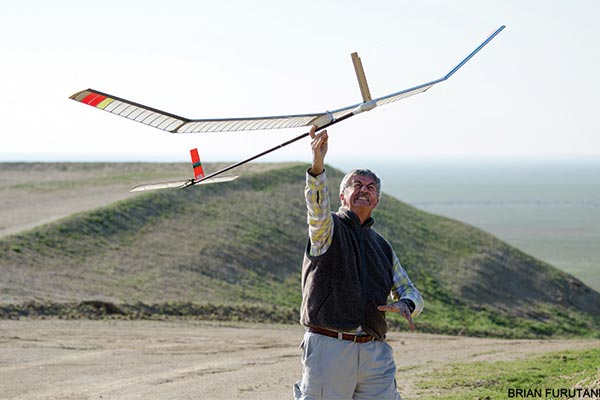
An intense moment-of-release photo of Peter Brocks (USA) launching an F1E model. Furutani photo.
Fabulous February, sometimes called Fab Feb, has become the lengthiest Free Flight gathering in North America and second in total attendance only to the AMA Outdoor Free Flight Nats in Muncie, Indiana.
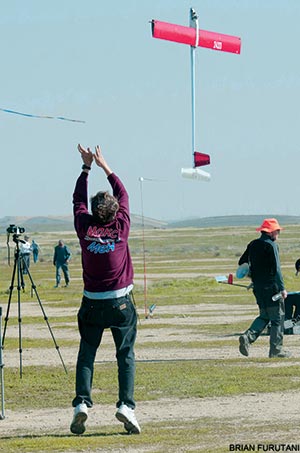
Former World Champion Matt Gewain (USA) launches an F1C folder aircraft. Photo by Brian Furutani.
The Elites of International Free Flight
Oleg Kulakovsky and Alex Andriukov were at Lost Hills as usual. During the last three decades, the pair has revolutionized the F1B Wakefield Rubber event. They produce models and parts for the world’s top competitors—models they’ve personally used to win seven of the last 12 F1B World Championships. Both are Ukrainian born, and Alex is now a US citizen and a regular competitor at Lost Hills. The father of the modern F1C model is Eugene Verbitsky, of Ukraine, who is a winner of three individual World Championships (1987, 1993, and 2011). His countryman, Artem Babenko, is a close second in stature, having won two World Championships. Both are elite designers and builders of F1C aircraft used by the world’s best fliers. Roy Summersby is another F1C luminary, having won the individual world title in 2013. Per Findahl, an enthusiastic two-time F1A world champion, was in attendance from frigid Sweden. Other former F1A world champions spanning three decades included Mike McKeever (USA), Stepan Stefanchuk (Ukraine), Matt Gewain (USA), Mikhail Kochkarev (Russia), Mike Fantham (Great Britain), and Sergey Makarov (Russia). It might as well be called Famous February.“Fab Feb is like a clan gathering. I enjoy meeting old and new friends and discussing model design. I always learn new things. I also enjoy the fine weather and the relaxed atmosphere of the competitions. I wish I could come year after year.” —Omri Sirkis, Israel
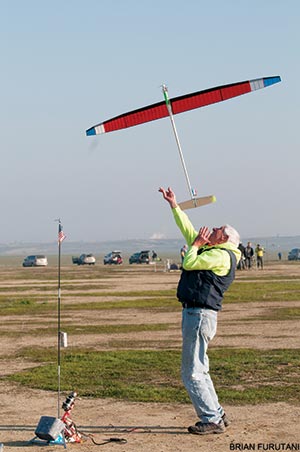
Mike Roberts (USA) launches in F1C. Furutani photo.
The Throwback Events
Undoubtedly, the best feature of Fab Feb is that it has evolved into a melting pot of Free Flight eras and disciplines. One-hundred-plus high-tech sportsmen from more than 30 nations share the field with some of America’s best traditional modelers, flying classic balsa designs such as Gollywocks and Stardusters. No other Free Flight gathering on the planet mixes the two worlds on such a grand scale. There’s a full complement of National Free Flight Society (NFFS) Nostalgia events, AMA Gas, Rubber, and Glider, and even Society of Antique Modelers (SAM) Old-Timer events. A glider pen is set up and both AMA and Catapult Glider contests are held each day—one for National Cup points and one for cash prizes (the Human Powered World Championship Awards, sponsored by the family of the late Paul MacCready). There are mass launches for special events such as E-36, E-20, and Gollywock. Perpetual trophies are awarded for Nostalgia Wakefield, Gollywock, F1A, F1B, and F1C.The Electric Revolution
The year 2016 marked the beginning of the F1S event, and Fab Feb featured the second and third contests of this highly anticipated gathering. F1S is identical to AMA E-36, except for the five-round format and the standard motor run set at 10 seconds. The afternoon flyoff for F1S at the Kiwi Cup provided some excellent drama in tricky lift conditions. Dick Ivers (USA) took the top spot as the only flier able to max on the 5-second flyoff run. Three years ago, I created the first E-36 World Open Championship, featuring a unique format of the AMA event, plus a single-flight evening mass launch, totaled into a single, factored score. This year, the World Open was generously sponsored by CB Model Designs and Bill Vanderbeek. The very deserving 2016 World Open Champion is Derek McGuckin from the state of Washington.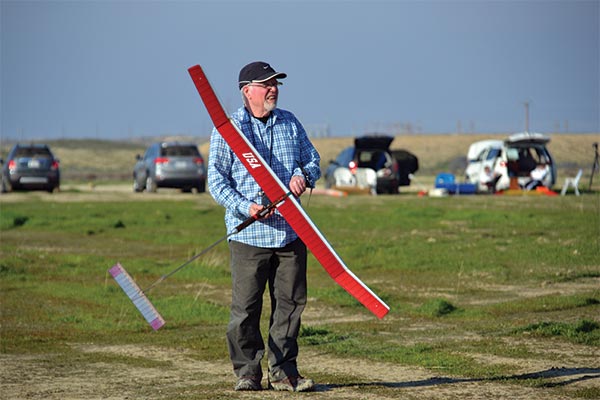
Dick Ivers readies his F1Q model for the Kiwi Cup flyoff. Dick won the F1S event the following day.
“Fab Feb at Lost Hills has to be the best Free Flight event on the planet. The field is great, the weather is great, the flying is great, and the people are great. To fly with people from 30 countries, with perhaps 10 past world champions among them, is a wonderful experience. We really like the flying, but we’d be happy to go there just to watch and catch up with old friends.” —Malcolm Campbell and Kathy Burford, Australia
Special Memories
It was widely agreed that it was the best weather ever for Lost Hills in February. It was simply outstanding-to-perfect the entire eight days. The many international sportsmen were not at any disadvantage having to retrieve on foot, and much test-flying was accomplished during the downtime between contests.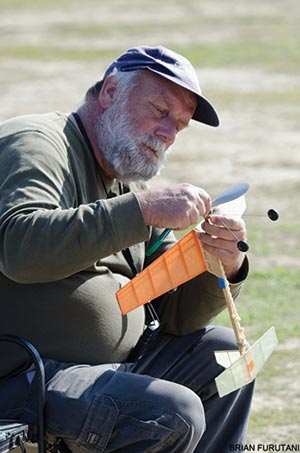
Ronnie Espolt, an RC flier from California, attended his first Fab Feb in 2016. Furutani photo.
“For a Swedish guy who sees no or very little sun from mid-October to the beginning of March, the dream about going to Lost Hills in February keeps the spirit up during the dark period. Just the thought to come to the sun, fly in a T-shirt, and disconnect from work is fantastic. “During Fab Feb week there is no news, no pressure from the boss, you live in a bubble, and it’s only about flying. To stay on the field is also a very important thing for me, to meet all my friends and just hang out. I have some of my best friends in the US. And with the stable weather, it’s usually very much flying compared to the time put in. “To have a new plane to test at Lost Hills is also a great feeling, to be able to fly it to the ground and compare the results with the best fliers in the world is just fantastic. And to have three contests in such a short time is a very good bonus, also. You know, of course, that those three contests will be some of the toughest to win during the year, but still, it’s a very good motivation to go.” —Per Findahl, Sweden
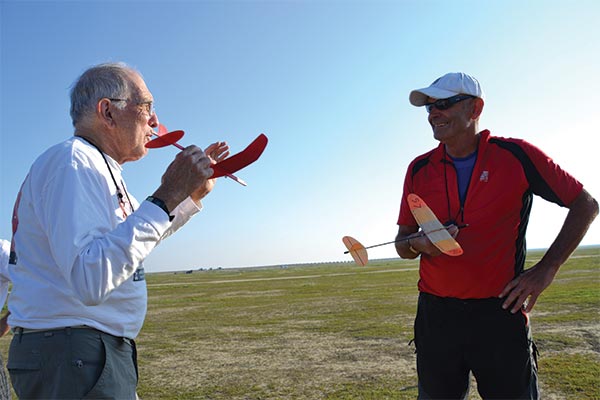
This year, Lee Hines finished second to Englishman Phil Ball (R) who had a 76-second final flight.
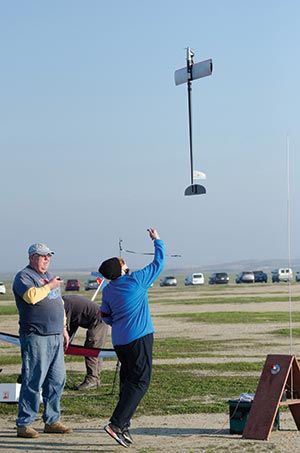
Larissa Savukhina (Russia) was the sole female entrant in F1C. She was consistently competitive, finishing third in the Kiwi Cup. Photo by Brian Furutani.
Wrapping Up
If you are even a casual fan of Free Flight and/or international air sports competition, you should make plans to attend Fabulous February. The anticipated dates for the 2017 gathering are February 11-19. Nowhere else in the world will you experience so many modeling cultures and differing languages on a common flightline with such outstanding fellowship. Free Flight forever!Maxes and Flyoffs
Major FAI Free Flight contests are scored based on the total time accrued throughout seven (sometimes five or three) individual flights. Each flight has a maximum target time, or “max” for short. Excess flight duration beyond the max is not counted. The events F1A, F1B, F1C, F1E, F1P, and F1Q stipulate the seven individual flights to be flown in one-hour rounds, with a standard max of 3 minutes. In the event of ties at the end of the seven rounds of regulation flying, a sudden-death, head-to-head “flyoff” (think overtime in football) is held. Flyoffs feature extended maxes (5 to 10 minutes) and shortened launch windows of only 10 minutes. This is when the pulse-pounding drama of Free Flight is revealed.International Free Flight Events
F1A: These are Towline Gliders with a total area of between 32 and 34 square decimeters (496 to 527 square inches), and 410 grams (14.46 ounces) minimum weight. There is a 50-meter maximum towline length. F1A includes a World Championship and World Cup event for Juniors and Seniors. F1B: This is an event for rubber-powered Wakefield models with a total area of 17 to 19 square decimeters (263.5 to 294.5 square inches), 200 grams (7.07 ounces) minimum empty weight, and 30 grams maximum rubber weight. It includes a World Championship and World Cup competition for Juniors and Seniors. F1C: These are glow-powered, alcohol-fueled models of approximately 600 square inches, with a maximum power loading of 300 grams per cc (10.58 ounces per cc), powered by up to 2.5cc (.15 cubic inch) engines on a 4-second maximum engine run. It includes a World Championship and World Cup event for Seniors. F1E: These magnetically steered Slope Soaring gliders have a maximum area of 150 square decimeters (2,325 square inches) and a maximum flying weight of 5 kilograms (176.37 ounces). The event includes a World Championship and World Cup competition for Seniors. F1Q: This event is for electric-powered models of approximately 400 square inches weighing 15 ounces. Motor-run time is based on a maximum of 5 joules allowed per gram of total weight. It is a World Cup event for Seniors. F1H: F1H is for small towline gliders with a maximum area of 18 square decimeters (279 square inches) and a minimum model weight of 220 grams. There is a maximum towline length of 50 meters. F1G: Models in this category are small, rubber-powered Coupe d’Hiver aircraft. The minimum model weight is 70 grams empty. The maximum rubber weight is 10 grams. F1J: This category is for small, glow-powered models with 1cc (.061 cubic inch) maximum displacement. The minimum weight is 160 grams (5.63 ounces), with a maximum engine run of 5 seconds. There are no fuel restrictions. F1S: This is the new small-electric class. Models must be powered by two or fewer LiPo battery cells (7.4 volts maximum). The model must weigh a minimum of 120 grams, with a projected wingspan maximum of 36 inches (92.30 centimeters). —Don DeLoach [email protected]Additional photos
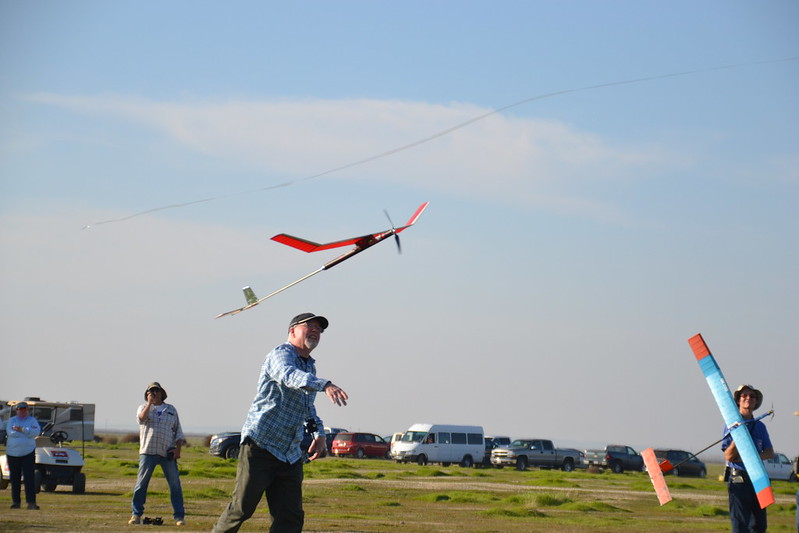










1 comments
Typo on the page...
Add new comment